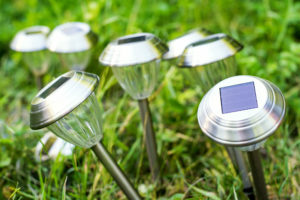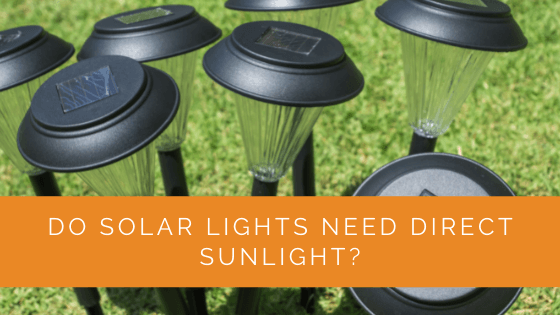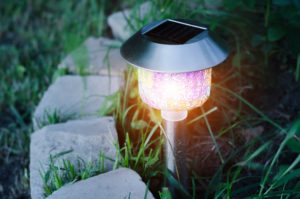Do solar lights need direct sunlight to work? This is a question that many people have, and the answer is not always clear. In this blog post, we will discuss the benefits of solar lights and whether or not they need direct sunlight to work. We will also provide some tips for placing solar lights in your garden!
Contents
- 1 Key Takeaways
- 2 Do Solar Lights Need Direct Sunlight to Charge?
- 3 How Do Charge Solar Lights Without Sunlight?
- 4 What are Solar Lights?
- 5 How Do Solar Lights Work?
- 6 What Are the Benefits of Solar Lights?
- 7 Where to Place Solar Lights?
- 8 Charging Solar Lights for the First Time
- 9 Case Study: Maximizing Solar Light Efficiency Without Direct Sunlight
- 10 Expert Insights From Our Solar Panel Installers About Solar Lights and Sunlight
- 11 Our Expertise in Solar Lights
- 12 Conclusion
- 13 Charging Solar Lights Without the Sun FAQs
Key Takeaways
- Solar lights do not necessarily need direct sunlight to work, but they perform best when exposed to it.
- To charge solar lights without direct sunlight, you can clean the solar panels, move the lights to sunny spots, use mirrors or artificial lighting, and employ LED lights.
- Solar lights are energy-efficient, environmentally friendly, versatile, and easy to install, making them a great choice for various outdoor lighting needs.
Do Solar Lights Need Direct Sunlight to Charge?
The answer is that solar lights do not necessarily need direct sunlight to work, but they will work best if they are exposed to direct sunlight.
Solar lights charge a battery using solar energy, which is collected by the solar panel on the light. If the solar panel is not exposed to direct sunlight, it will not be able to collect as much energy and the light will not work as well.
If you are unable to place your solar light in a spot that receives direct sunlight, don’t worry! Solar lights will still work, they just might not work as well. Read on for our recommendations for charging solar lights with direct sunlight.
How Do Charge Solar Lights Without Sunlight?
Here are our recommendations for charging solar lights without the sunlight:
Clean Your Solar Panels
Always clean your solar lights so they charge as efficiently as possible. You can clean your solar lights with a damp cloth and dish soap or mild detergent.
Move the Lights
If you can’t place your solar light in an area with direct sunlight, try to place it in a sunny spot to receive as much sunlight as possible. A sunny spot is an area that receives indirect sunlight throughout the day.
Use Mirrors
If you are struggling to get enough sunlight to your solar lights, try using a reflective surface to help. You can place a mirror, piece of metal or even a white sheet of paper underneath your solar light to reflect the sunlight onto the solar panel.
Use Artificial Lighting
You can use artificial lighting such as incandescent light bulbs to charge the solar light. Place the light about a foot away from the solar panel and leave it on for several hours.
Use LED Lights
Use a power source with more intense light, such as an LED flashlight to charge your solar lights. Point the LED light at the solar panel for about 30 minutes.

What are Solar Lights?
Solar lights are a type of outdoor lighting that uses solar energy to power the light. They are a great way to save energy and money, as they do not require any electricity to operate. They are also very easy to install, as there is no need to run electrical wiring. You can use solar lights to light up walkways, gardens, decks, patios, driveways, and more.
How Do Solar Lights Work?
Solar lights work by collecting solar energy from the sun. The photovoltaic cells and the solar panel on the light convert the daylight into electrical energy, which is then used to charge a battery. The rechargeable batteries power the light at night.
What Are the Benefits of Solar Lights?
Here are some of the benefits of solar lights:
- Solar lights are a great way to save energy and money: They do not require any electricity to operate and are very easy to install.
- Solar lights are environmentally friendly: They do not produce any emissions or pollutants.
- Solar lights are very versatile: They can be used to light up walkways, gardens, and other outdoor areas.
- Solar lights are available in a variety of styles to suit any needs: You can find solar lights that are designed to look like traditional light fixtures, as well as more modern and decorative options.
Where to Place Solar Lights?
Here’s a list of ideas for where to place your solar lights:
- In your garden: Place solar lights along pathways or in areas where you want to add some extra light.
- On your deck or patio: Solar lights can provide extra light for entertaining or relaxing outside.
- Along your driveway: Solar lights can help create a safe and well-lit path to your home.
- In the yard: You can use solar lights to light up trees, shrubs, and other landscaping features.
- On the front porch: A welcoming light on your front porch is a great way to greet guests.
- In the flower bed: Position solar lights among flowers for an extra splash of color at night.
- Wherever you need extra light: Solar lights are a great way to add some extra light to any area.
Charging Solar Lights for the First Time
Have you purchased new solar lighting and wondering how to charge for the first time? Here are the steps you need to take:
- Remove the solar light from its packaging and set it in an area with direct sunlight.
- Allow the solar light to charge for 8 hours.
- Once the solar light is fully charged, it will stay lit for 6-8 hours.

Case Study: Maximizing Solar Light Efficiency Without Direct Sunlight
Background
At Solar Panels Network USA, we are committed to helping homeowners make the most of renewable energy solutions. This case study explores how we optimized the performance of solar lights in a residential property that did not receive direct sunlight consistently.
Project Overview
A homeowner approached us with concerns about the effectiveness of their solar lights, as their garden was partially shaded by trees and nearby buildings. They wanted to ensure their solar lights could still perform well despite limited direct sunlight.
Initial Consultation and Assessment
Identifying Challenges
The primary challenge was to determine how to maximize the efficiency of solar lights in areas with inconsistent sunlight. We needed to assess the current placement of the lights and identify potential solutions to enhance their charging capacity.
Site Evaluation
Our team conducted a comprehensive site survey to evaluate the garden’s sunlight exposure. We identified areas with the most shade and those that received indirect sunlight throughout the day.
Implementation
Strategic Placement of Solar Lights
We recommended relocating some of the solar lights to spots that received more indirect sunlight. By positioning the lights in these areas, we ensured they could still absorb sufficient light to charge their batteries.
Cleaning and Maintenance
We advised the homeowner on the importance of keeping the solar panels clean. Dust and debris can significantly reduce the panels’ ability to collect light. Regular cleaning with a damp cloth and mild detergent was recommended to maintain optimal efficiency.
Using Reflective Surfaces
To enhance light absorption, we suggested using reflective surfaces like mirrors or white boards placed near the solar panels. These surfaces help redirect sunlight onto the panels, increasing their exposure even in shaded areas.
Employing Artificial Light Sources
For areas that remained heavily shaded, we recommended using LED flashlights or incandescent bulbs to provide additional light. Placing these lights close to the solar panels for a few hours daily helped ensure the batteries received adequate charge.
Results
Improved Charging Efficiency
By following our recommendations, the homeowner noticed a significant improvement in the charging efficiency of their solar lights. Even on cloudy days, the lights were able to store enough energy to function effectively at night.
Enhanced Illumination
The strategic placement and additional light sources resulted in brighter and more reliable illumination throughout the garden. The homeowner was pleased with the enhanced visibility and aesthetic appeal of their outdoor space.
Cost Savings
Despite the initial investment in reflective surfaces and additional light sources, the homeowner experienced overall cost savings due to the reduced need for traditional electric lighting. The solar lights continued to provide a cost-effective and environmentally friendly lighting solution.
Summary
Our expertise in optimizing solar light performance enabled us to address the homeowner’s concerns about limited sunlight exposure. By employing strategic placement, regular maintenance, and innovative light-enhancing techniques, we maximized the efficiency and effectiveness of their solar lights. This case study highlights the adaptability of solar lighting solutions, even in challenging conditions.
Expert Insights From Our Solar Panel Installers About Solar Lights and Sunlight
Solar lights are designed to be efficient even in less-than-ideal conditions. While they perform best with direct sunlight, they can still gather and store energy on cloudy days, making them a reliable option year-round.
Lead Solar Engineer
Proper placement is key to maximizing the efficiency of solar lights. Ensuring they receive as much sunlight as possible, even if indirect, can significantly improve their performance.
Senior Solar Technician
Utilizing reflective surfaces or artificial light sources can help charge solar lights in shaded areas. This adaptability makes solar lights a versatile solution for various outdoor lighting needs.
Renewable Energy Specialist
Our Expertise in Solar Lights
At Solar Panels Network USA, we’re here to provide you with valuable information and support regarding solar lighting. With our experience and understanding of the solar lighting industry, our team of experts is prepared to assist you in finding the right lighting solution for your needs. Whether you’re interested in improving your outdoor spaces, conserving energy, or adopting a more sustainable approach, we’re well-equipped to help. Please feel free to contact us with any questions or inquiries.
Conclusion
Solar lights are a great way to add extra light to your home. They are easy to install, environmentally friendly, and available in a variety of styles. You can use solar lights indoors or outdoors, and they will charge during the day so you can enjoy them at night.
Be sure to place your solar lights in an area where they will receive direct sunlight for the best results, but if they can’t be placed in direct sunlight, use our recommendations above to charge them the best you can.
Try to expose your solar lights to direct sunlight for at least six hours every day. This will ensure that the batteries can charge fully. A fully charged solar light can then run for at least eight hours.
Charging Solar Lights Without the Sun FAQs
Do Solar Lights Work in Winter?
Solar lights will still work in winter, but they may not provide as much light as they do in summer. This is because the days are shorter and there is less sunlight available to power the light.
Do Solar Lights Work Cloudy Days?
Solar lights will still work on cloudy days, but they may not provide as much light as they do on sunny days. This is because there is less sunlight available to power the light.
Can Solar Lights Be Used in Shade?
Solar lights can be used in shade, but they will not work as well as they would if they were placed in direct sunlight. If your solar lights are not working well in shady areas, try moving them to a sunnier spot.
Can I Use an LED Flashlight to Charge My Solar Lights?
Yes, you can use an LED flashlight to charge your solar lights. Just point the light at the solar panel for about 30 minutes.
Are There Any Risks to Installing Solar Lights?
There is no risk to installing solar lights. They are very easy to install and do not require any electrical wiring. You simply need to place the solar panel in a sunny spot and attach the light fixture where you want it. If you have any questions or concerns, consult with a professional installer.
About the Author
Solar Panels Network USA stands at the forefront of solar energy solutions, driven by a team of seasoned solar engineers and energy consultants. With over decades of experience in delivering high-quality solar installations and maintenance, we are committed to promoting sustainable energy through customer-centric, tailored solutions. Our articles reflect this commitment, crafted collaboratively by experts to provide accurate, up-to-date insights into solar technology, ensuring our readers are well-informed and empowered in their solar energy decisions.


